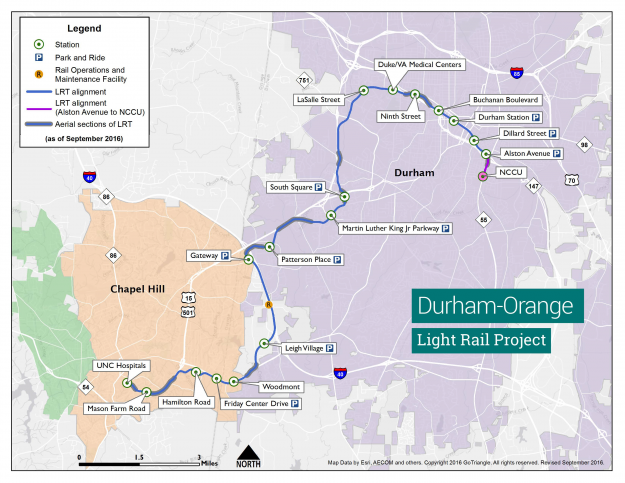The light rail project connecting Chapel Hill and Durham has cleared a major hurdle.
Natalie Murdock is the spokesperson on the project for GoTriangle. She says the Federal Transit Administration signed off on the Draft Environmental Impact Statement last Thursday.
“Essentially, this allows us to go forward and show the public everything that we’ve been working on at a very intense pace,” she says, “taking a four-year process and really trying to whittle that down into two years.”
Murdock says this draft statement focused on potential environmental impacts along the pathway from Chapel Hill to Durham.
“Throughout those 17 miles, we did have a number of environmentally-sensitive areas,” she says. “In this document, you will see our recommendation as to how we can offset some of those environmental impacts.
“And also ways that we can try to avoid impacts to communities and institutions.”
Murdock adds work has narrowed down on the potential path of the tracks.
The funding for the project is coming from local, state, and federal funds. Murdock says that will follow a 25-25-50 format, with 25 percent from the local level through a sales tax increase already approved by Orange and Durham County voters, 25 percent from the North Carolina Department of Transportation, and 50 percent to come from the federal government.
A public comment period will open for 45 days after the formal FTA approval, which is expected on Friday.
Murdock says that will set off the next chain of events on the timeline.
“That final document will be finalized around February 2016,” she says. The final environmental-impact document approval will lead to additional authorization being sought from the FTA regarding engineering. “At that time, if the federal government allows us to proceed with the engineering, then in 2019 we will pursue 50 percent funding from the federal government and begin construction in 2019.”
The public comment period will include two public information sessions and two public hearings. The Friday Center will host an information session on September 15 and a public hearing on September 29.
“We need to hear from the public how they think the project will help their community,” Murdock says, “what concerns they have about how it will impact their community; if they think it will impact their access to work; if it will impact the access that customers will have to a business owner’s business.
“Those are the types of comments that we do need to hear from the public.”





This horror would destroy the spirit and continuity our communities, suck hundreds of millions of tax dollars away from our needs in operating losses, to enrich political cronies when Noone wants it. It will create instant blight and ghettos, and is being sold on a green ticket where it will destroy land and create ugliness and pollution as it rides empty, if we can’t make bus service profitable this is nothing but stealing to pay cronies.
Develop Erwin Road and Pickett, and 54, improve busses, encourage car and vanpooling, morose not destroy and DO NOT COMMIT our communities to a dead albatross which will drag us down for generations!